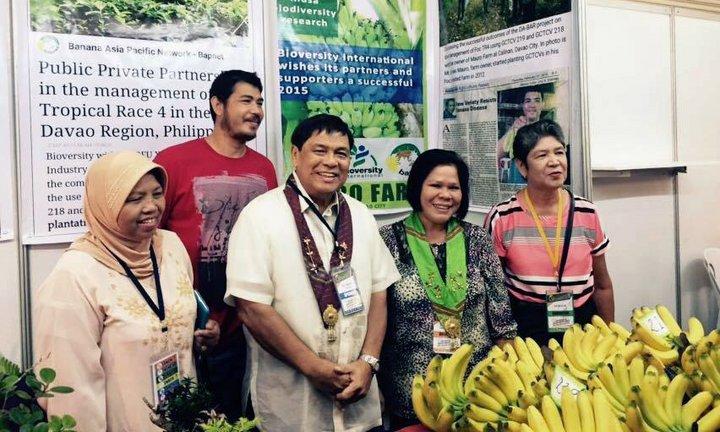Tackling banana disease in the Philippines

Fusarium wilt management was a key topic at the Philippines Banana Congress held in Davao on 6-7 October 2016. Bioversity International’s Agustin Molina highlighted efforts to manage the disease through the use of resistant banana varieties.
Banana production is affected by a wide range of pests and diseases that can cause up to 100% of harvest loss. The management of one of these diseases, Fusarium wilt, was a key topic at the Philippines Banana Congress held in Davao on 6-7 October 2016.
Bananas are the backbone of the country’s economy and food security. Globally, the Philippines is one of the largest banana exporters, and the leading exporting country in Asia. In 2005, a new strain of Fusarium wilt, known as Tropical Race 4 or Foc TR4, was reported in the Philippines. Caused by a fungus that enters the plant through the roots and causes severe damage that eventually kills the banana plant, the disease cannot be cured or managed using chemicals. The only option for continued production in Foc TR4-infested soils is replacing susceptible varieties with resistant ones.
In his plenary speech at the Congress, Bioversity International’s Honorary Research Fellow and Regional Coordinator of Banana Asia-Pacific Network (BAPNET) Agustin B. Molina discussed the management of Foc TR4 through an integrated management system revolving around the use of resistant varieties. These varieties – known as GCTCV 218 and 219 from the Taiwan Banana Research Institute – are now used by both small-scale growers and big companies to manage farms affected by Foc TR4. Molina also brought attention to the need to make this planting material more available to small-scale banana growers.
To adapt these varieties to the export market needs, Bioversity International has been working with several partners, including the private sector. All these partners – including DA-BAR, PCAARD, DA-BPI, DA-Reg XI, UPLB, USEP*, big banana companies and small growers – worked together to develop a disease management strategy.
The Banana Congress was attended by more than 1,000 people including growers, researchers, extension workers, traders, policymakers, students and government officials. The Philippines President of the Republic, Rodrigo Duterte, and the Secretary of Agriculture, Manny Pinol, gave a keynote. The President recognized the need of strengthening banana research to sustain growth of the banana industry that is faced with many technical and market challenges.
________________
*DA-BAR- Department of Agriculture-Bureau of Agricultural Research
PCAARRD - Philippine Council for Agriculture, Aqua Resources Research and Development
DA-BPI, Department of Agrciculture-Bureau of Plant Industry
DA-REg XI- Department of Agriculture-Region XI
UPLB- University of the Philippines Los Banos
This research contributes to the CGIAR Research Program on Roots, Tubers and Bananas
Photo: Booth exhibit of MAURO FARMS - farm collaborator of Bioversity International with its NARS partners, DA-Bureau of Agricultural Research, Bureaau of Plant Industry and DA-REgion XI, displaying fruits of the Fusarium wilt resistan varieties GCTCV 218 and GCTCV 219. Credit: BAPNET
